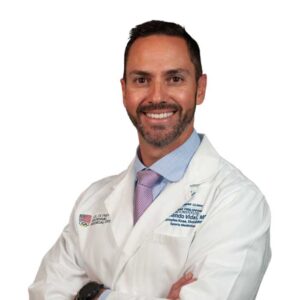What is the anatomy of a meniscus?
Each knee has two menisci which are wedge-shaped fibrocartilage discs that act as shock absorbers. The peripheral third of each meniscus has a blood supply which facilitates healing and influences our decision on whether repair or resect the torn portion. The inner portion is thinner and tears in this portion of the meniscus often require surgical resection because it cannot be sutured. Dr. Armando Vidal, orthopedic knee surgeon, serving patients in Vail, Aspen and the surrounding Denver, Colorado communities specializes in helping patients with meniscal injuries and knee pain.
Each knee has two menisci which are wedge-shaped fibrocartilage discs that act as shock absorbers. The peripheral third of each meniscus has a blood supply which facilitates healing and influences our decision on whether repair or resect the torn portion. The inner portion is thinner and tears in this portion of the meniscus often require surgical resection because it cannot be sutured. Dr. Armando Vidal, orthopedic knee surgeon, serving patients in Vail, Aspen and the surrounding Denver, Colorado communities specializes in helping patients with meniscal injuries and knee pain.
What is a torn meniscus?
Meniscus tears are one of the most common knee injuries, especially in young, active adults and athletes. A tear occurs when the strong fibrocartilage rips or separates from its peripheral capsular (soft tissue) attachment. Tears can occur in a variety of patterns and locations. In general, the simpler the pattern and the closer the tear is to the periphery (blood supply) the more amenable it is to repair.
What causes a meniscus tear?
Sudden meniscus tears can happen from a sports injury, when an athlete may squat and twist their knee. It can also occur from direct contact as seen with a football tackle. However, Dr. Vidal sees a vast majority of meniscal tears in patients who are over the age of 40. These tears are often non-traumatic and more a result of meniscal wear and tear.
What are the symptoms of a torn meniscus?
The most common symptom of a torn meniscus is knee pain. Other symptoms include:
- A popping sensation or sound at the time of injury
- Knee stiffness
- Swelling
- Limited range of motion
- Catching or locking of the knee
- Feeling of instability in the knee, or the knee “giving away”
How are tears of the knee cartilage diagnosed?
A thorough history, physical exam and advanced imaging (MRI) can diagnose the vast majority of meniscal tears. Meniscal tears at the periphery (meniscocapsular or ramp lesions and fascicle tears laterally) are notoriously difficult to diagnose and require experience for an accurate diagnosis. For patients in Vail, Aspen and the surrounding Denver Colorado communities, Dr. Vidal will discuss symptoms and examine the injured knee.
What is a meniscus repair?
The goal of all meniscal treatment it to preserve as much meniscal tissue and therefore function as possible. In an ideal scenario, a symptomatic meniscal tear is repaired (stitched together) to restore and preserve meniscal function. However, not all meniscal injuries are amenable to repair. The ideal meniscal injury for repair is a vertical, peripheral injury in an otherwise healthy (non-arthritic) knee.
The ideal candidate has the following:
- Healthy, non-arthritic knee
- Normal (or correctable) alignment
- Stable (or surgically stabilized) knee
- Favorable tear pattern
- Healthy weight
In fact, the majority of meniscal tears are not amenable to repair and as such meniscectomy or partial meniscectomy, remains the most common orthopedic operation.
How do you repair the meniscus?
There are a variety of techniques that have been described to repair meniscal tears. The Gold Standard remains the inside-out approach. In this procedure, the tear is repaired arthroscopically with the aid of a small incision on the inner or outer part of the knee. Sutures are passed across the repair site to oppose the torn fibers – much like suturing a skin incision. The repair can be biologically enhanced by poking holes into the bone so that marrow (and stem cells) bathe the repair site. We may also consider augmentation with a biologic like PRP (platelet rich plasma).
Are there any downsides to repairing the meniscus?
As with any procedure there are pros and cons. The biggest advantage of repair is that, if successful, it can restore meniscal function and decrease your risk of arthritis.
However, meniscal repair requires a longer recovery (4 ½ months) and carries an approximately 10-25% risk of retear and reoperation. Deciding which procedure is best for you is made through shared decision making between you and Dr. Vidal.
What happens after meniscus repair?
Following a surgical repair, the knee is placed in a brace to immobilize the joint for 4 weeks. Weight bearing restriction maybe employed depending on your tear pattern and repair. Physical therapy will begin shortly after surgery and progress until the knee is strengthened and has full motion. Full recovery takes approximately 4 ½ months.
Meniscus Restoration Surgeon
The meniscus is a disc that acts as a shock absorber in the knee. It can be damaged in a number of ways, including athletic activity and everyday actions. Injuries to the meniscus range in severity, however, it is advised to see a professional to evaluate the injury and determine the best course of treatment. Complex knee surgeon, Doctor Armando Vidal provides diagnosis as well as treatment for patients in Vail, Aspen, and the surrounding Denver, Colorado communities who have experienced damage to the meniscus. Contact Dr. Vidal's team today!

Locations
180 S Frontage Rd W
Vail, CO 81657
226 Lusher Court
Ste 101
Frisco, CO 80443
322 Beard Creek Road
Edwards, CO 81632


